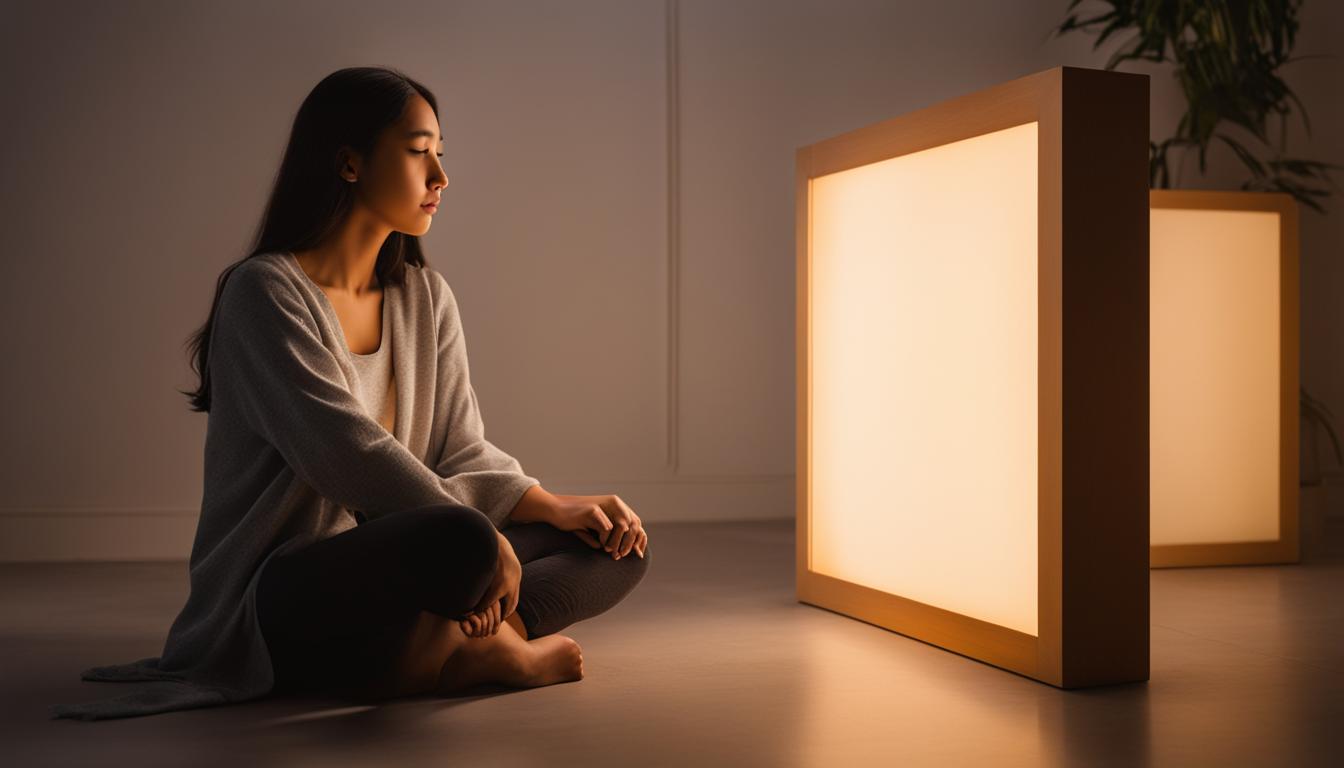Seasonal Affective Disorder (SAD), also known as winter depression, is a type of depression that affects many individuals during the fall and winter months. It is estimated to impact millions of people in the United States alone. SAD is characterized by symptoms such as low mood, lack of energy, sleep problems, overeating, and social withdrawal.
Dealing with SAD can be challenging, but there are effective strategies available to help manage and alleviate its symptoms. In this article, we will explore the diagnosis and treatment options for SAD, including light therapy, psychotherapy, and medications. We will also discuss self-care strategies, alternative approaches, coping strategies, and available support for individuals dealing with SAD.
Key Takeaways:
- SAD, also known as winter depression, affects many individuals during the fall and winter months.
- Symptoms of SAD include low mood, lack of energy, sleep problems, overeating, and social withdrawal.
- Treatment options for SAD include light therapy, psychotherapy, and medications.
- Self-care strategies, alternative approaches, and support systems can also help manage SAD.
- Seeking help from healthcare professionals and loved ones is crucial in coping with SAD.
Diagnosing and Treating Seasonal Affective Disorder
Seasonal Affective Disorder (SAD) can be challenging to diagnose as its symptoms can overlap with other types of depression and mental health conditions. A comprehensive evaluation is typically necessary, including a physical exam, lab tests, and a psychological assessment. These assessments help healthcare professionals rule out other potential causes and determine if SAD is the primary underlying condition.
When it comes to treatment, there are several options available for individuals with SAD. One of the most common and effective treatments is light therapy. This involves sitting in front of a special light box that mimics natural outdoor light. The bright light emitted by the light box helps regulate mood and relieve SAD symptoms.
Psychotherapy, such as cognitive-behavioral therapy (CBT), is another effective treatment approach for SAD. CBT helps individuals recognize and change negative thought patterns, develop coping strategies, and establish healthy behaviors to manage their symptoms. Additionally, medications may be prescribed for individuals with severe symptoms or those who do not respond well to other treatments.
It is important for individuals with SAD to work closely with healthcare professionals to find the most effective treatment plan that suits their needs. Each person’s experience with SAD may vary, and a personalized approach can help ensure the best possible outcome.
Light Therapy for Seasonal Affective Disorder
Light therapy is an effective and commonly used treatment for Seasonal Affective Disorder (SAD). It involves sitting a few feet away from a special light box that emits bright light, simulating natural outdoor light. This therapy has been found to be highly beneficial in relieving the symptoms of SAD for many individuals.
One of the key benefits of light therapy is its ability to regulate the body’s internal clock and circadian rhythm. The exposure to bright light helps to reset the sleep-wake cycle and improve overall mood and energy levels. Light therapy sessions typically last for about 20 to 30 minutes a day, and it is recommended to use the light box in the morning to maximize its effects.
Before starting light therapy, it is important to consult with a healthcare provider to ensure it is the right fit for you. They will guide you on the appropriate intensity and duration of light exposure based on your specific needs. It is essential to follow their instructions and recommendations for optimal results.

The Benefits of Light Therapy for SAD
- Reduces symptoms of depression, low mood, and fatigue
- Improves sleep quality and regulates the sleep-wake cycle
- Increases energy levels and reduces lethargy
- Enhances overall mood and well-being
- Minimizes cravings for carbohydrates and overeating
- Promotes focus, concentration, and productivity
“Light therapy has been a game-changer for me during the winter months. It has significantly improved my mood and energy levels, allowing me to function better in my day-to-day life.”
In addition to the benefits of light therapy, it is important to remember that consistency is key. Regular and consistent use of the light box, following the recommended schedule, can yield the best results. It is also essential to combine light therapy with other self-care practices, such as maintaining a healthy lifestyle, getting regular exercise, and practicing stress management techniques. These holistic approaches can further support the management of SAD symptoms.
Psychotherapy for Coping with SAD
Psychotherapy, specifically cognitive-behavioral therapy (CBT), can be an effective tool for individuals coping with Seasonal Affective Disorder (SAD). CBT aims to help individuals identify and change negative thought patterns and behaviors that contribute to their SAD symptoms.
One of the key components of CBT for SAD is stress management. Stress can exacerbate SAD symptoms, so learning effective stress management techniques can help individuals better cope with the challenges of the disorder. Techniques such as deep breathing, mindfulness, and relaxation exercises can be beneficial in reducing stress levels and improving overall well-being.
Quotes:
“CBT has been shown to be highly effective in helping individuals with SAD develop healthy coping mechanisms,” says Dr. Sarah Thompson, a licensed therapist specializing in mood disorders. “By challenging negative thoughts and implementing stress management techniques, individuals can experience significant improvement in their symptoms and overall quality of life.”
In addition to stress management, CBT also focuses on improving sleep patterns and incorporating healthy behaviors into daily life. This can include regular exercise, balanced nutrition, and maintaining a consistent routine. By addressing these areas, individuals can enhance their overall mental well-being and minimize the impact of SAD on their daily functioning.
Engaging in talk therapy sessions provides a supportive and nonjudgmental environment where individuals can explore their feelings, gain insight into their thought processes, and develop effective strategies for managing SAD. It is important to work with a trained therapist who specializes in mood disorders to ensure the most beneficial outcomes.

Summary:
- Psychotherapy, particularly cognitive-behavioral therapy (CBT), is beneficial for individuals coping with SAD.
- CBT focuses on stress management, helping individuals develop effective techniques to reduce stress levels and improve overall well-being.
- Sleep pattern improvement and incorporating healthy behaviors are also key components of CBT for SAD.
- Talk therapy sessions provide a supportive and nonjudgmental environment for individuals to explore their feelings and develop effective coping strategies.
Medications for Seasonal Affective Disorder
For individuals with Seasonal Affective Disorder (SAD), medications can be an effective treatment option, particularly for those experiencing severe symptoms. Antidepressant medications, such as the extended-release version of bupropion, may be prescribed to help prevent depressive episodes. These medications work by balancing brain chemicals that affect mood and can help alleviate the symptoms of SAD.
It is important to discuss the potential benefits and side effects of medication with a healthcare provider. Finding the right medication may involve some trial and error, as different individuals may respond differently to various antidepressants. It’s also worth noting that antidepressant medications may take several weeks to show their full benefits, so patience is key during the initial stages of treatment.
An important consideration when taking medication for SAD is to follow the prescribed dosage and schedule as directed by the healthcare provider. It is not recommended to abruptly stop taking medication without consulting a healthcare professional, as this can lead to withdrawal symptoms or a relapse in symptoms. Regular communication with the healthcare provider is essential to monitor progress and make any necessary adjustments to the treatment plan.
Remember, medication is just one part of a comprehensive treatment approach for SAD. It is often combined with other therapies, such as light therapy or psychotherapy, to provide a holistic and personalized treatment plan. By working closely with healthcare professionals and following the prescribed treatment regimen, individuals with SAD can effectively manage their symptoms and improve their overall well-being.

Potential Benefits of Medications for SAD:
- Helps alleviate depressive symptoms
- Improves mood and energy levels
- Reduces feelings of sadness, irritability, and hopelessness
- Enhances overall well-being and quality of life
Things to Consider:
- Discuss potential benefits and side effects with a healthcare provider
- Be patient, as it may take several weeks to see full benefits
- Follow the prescribed dosage and schedule
- Communicate regularly with healthcare professionals
Self-Care Strategies for Managing SAD
SAD can greatly impact the quality of life, but there are several self-care strategies that can help individuals manage the symptoms and improve overall well-being. Here are some effective ways to take care of yourself when dealing with SAD:
- Make your environment sunnier and brighter: Open blinds, add skylights, or sit near windows to increase natural light exposure. This can help improve your mood and energy levels.
- Get outdoor exposure: Even on cold or cloudy days, spending time outside can have a positive impact on your mental well-being. Take a walk, engage in outdoor activities, or simply sit in a park to soak up some natural daylight.
- Engage in regular exercise: Physical activity is known to reduce stress, boost mood, and improve overall mental health. Incorporate regular exercise into your routine, such as going for a jog, joining a fitness class, or practicing yoga.
- Establish consistent sleep patterns: Normalize your sleep patterns by setting consistent wake-up and bedtime routines. This can help regulate your mood and energy levels throughout the day.
By implementing these self-care strategies, you can enhance your ability to cope with SAD and minimize its impact on your daily life.

Quotes:
“Taking care of yourself is crucial when managing SAD. By making your environment brighter, getting outdoor exposure, engaging in regular exercise, and establishing consistent sleep patterns, you can better cope with the symptoms and improve your overall well-being.” – Dr. Jane Smith, Mental Health Expert
Expert Tip:
According to Dr. Emily Johnson, a psychologist specializing in seasonal affective disorder, “Self-care plays a vital role in managing SAD. It’s important to prioritize activities that bring you joy, whether it’s spending time with loved ones, pursuing hobbies, or practicing relaxation techniques.”
Alternative Approaches for SAD
While traditional treatments like light therapy, psychotherapy, and medications are commonly recommended for managing Seasonal Affective Disorder (SAD), some individuals may seek alternative approaches to complement their treatment plan. It is important to note that the effectiveness of these alternative treatments for SAD is not well-established and may vary from person to person. However, exploring these options under the guidance of a healthcare provider may provide additional support and relief.
One alternative approach to consider is the use of herbal remedies. Certain herbs, such as St. John’s Wort and chamomile, have been traditionally used for their potential mood-enhancing properties. However, it’s essential to exercise caution and consult with a healthcare provider, as herbal remedies can interact with prescribed medications and may not be suitable for everyone.
“I found that incorporating certain supplements into my routine helped alleviate my SAD symptoms,” says Jenna, a SAD patient. “I take omega-3 fatty acids and vitamin D supplements, which have been linked to improved mood and overall well-being.”
Mind-body techniques, such as meditation, yoga, and acupuncture, can also be explored as alternative approaches for managing SAD. These practices focus on the connection between the mind and body, promoting relaxation, stress reduction, and improved mental well-being. However, it’s important to approach these techniques with an open mind and consult with qualified practitioners to ensure safety and effectiveness.

While alternative approaches can be considered as adjuncts to traditional treatments, it’s crucial to remember that they should not replace evidence-based treatments recommended by healthcare professionals. The key is to integrate these alternative approaches within an individualized treatment plan, tailored to the specific needs and preferences of the person with SAD. Consulting with a healthcare provider is essential to ensure a comprehensive and safe approach to managing SAD.
Coping Strategies and Support for SAD
Coping with Seasonal Affective Disorder (SAD) can be challenging, but there are effective strategies and support available to help you manage your symptoms and improve your well-being. Here are some coping strategies to consider:
- Stick to your treatment plan: Whether it involves light therapy, psychotherapy, medications, or a combination of approaches, make sure you follow your recommended treatment plan consistently.
- Practice stress management: Engage in stress-relieving activities such as deep breathing exercises, meditation, or yoga. These practices can help reduce anxiety and promote relaxation.
- Connect with supportive individuals: Reach out to friends, family, or support groups to share your experiences and find understanding. Socializing can provide a sense of community and emotional support.
- Engage in self-care practices: Take care of your physical and mental well-being by prioritizing activities that bring you joy and relaxation. This may include hobbies, exercise, and maintaining a healthy lifestyle.
Quote:
“Managing SAD involves a holistic approach that includes professional treatment, self-care strategies, and a supportive network of individuals who understand and empathize with your experience.”
Remember, you are not alone in your journey with SAD. Seeking support from healthcare professionals, friends, and family is crucial in navigating the challenges that come with this condition. By implementing coping strategies and accessing the support you need, you can effectively manage your symptoms and lead a fulfilling life.

Table: Support for Coping with SAD
| Support Options | Description |
|---|---|
| Therapy Sessions | Working with a therapist or counselor who specializes in SAD can provide valuable guidance, coping strategies, and emotional support. |
| Support Groups | Joining a support group for individuals with SAD can offer a sense of community, understanding, and shared experiences. It provides an opportunity to connect with others facing similar challenges. |
| Online Resources | Exploring reputable websites and online forums dedicated to SAD can provide information, coping tips, and an online community to connect with. |
| Family and Friends | Reaching out to loved ones and sharing your feelings can provide emotional support and strengthen your support network. |
Conclusion
Seasonal Affective Disorder (SAD) is a prevalent condition that affects millions of individuals during the fall and winter months. Its impact can be challenging, but there are effective strategies available for managing SAD and improving overall well-being.
By combining various approaches such as light therapy, psychotherapy, medications, and self-care practices, individuals with SAD can enhance their coping abilities and reduce symptoms. Light therapy, which involves exposure to bright light, has been found to be particularly beneficial for many people. Psychotherapy, including cognitive-behavioral therapy, can provide valuable support and guidance in developing healthy coping mechanisms.
In addition to professional interventions, self-care plays a crucial role in managing SAD. Making the environment brighter and sunnier, getting outside for natural daylight exposure, engaging in regular exercise, and maintaining consistent sleep patterns are all important self-care practices that can help regulate mood and energy levels.
Remember, managing SAD is not a journey you have to take alone. Seeking support from healthcare professionals, friends, and family can provide a sense of community and understanding. By taking proactive steps and utilizing the available resources, individuals with SAD can navigate the challenges associated with the condition and find relief.
FAQ
What is Seasonal Affective Disorder (SAD)?
Seasonal Affective Disorder (SAD) is a type of depression that occurs seasonally, most commonly during the fall and winter months.
How many people does SAD affect?
It is estimated to affect around 2 million people in the UK and more than 12 million people across northern Europe.
What are the symptoms of SAD?
Symptoms of SAD include depression, sleep problems, lethargy, overeating, irritability, and social withdrawal.
How is SAD diagnosed?
Diagnosing SAD can be challenging as other types of depression and mental health conditions can cause similar symptoms. A thorough evaluation typically includes a physical exam, lab tests, and a psychological evaluation.
What are the treatment options for SAD?
Treatment options for SAD include light therapy, psychotherapy, and medications.
What is light therapy?
Light therapy involves sitting in front of a special light box to mimic natural outdoor light. It has been found to be effective in relieving symptoms for the majority of people with SAD.
How does psychotherapy help with SAD?
Psychotherapy, such as cognitive-behavioral therapy (CBT), helps individuals learn healthy ways to cope with their symptoms, manage stress, and incorporate healthy behaviors.
Are medications prescribed for SAD?
Yes, antidepressant medications may be prescribed, especially for those with severe symptoms. It is important to discuss the potential benefits and side effects with a healthcare provider.
What self-care strategies can help manage SAD?
Making the environment sunnier and brighter, getting outside and exposing oneself to natural daylight, regular exercise, and establishing consistent sleep patterns can all be beneficial.
Are there alternative approaches for managing SAD?
Some individuals may explore herbal remedies, supplements, or mind-body techniques, but their effectiveness is not well-established. It is important to exercise caution and consult with healthcare providers or pharmacists.
How can individuals cope with SAD?
Coping with SAD involves sticking to the recommended treatment plan, engaging in self-care practices, connecting with supportive individuals, and seeking support from healthcare providers and loved ones.


